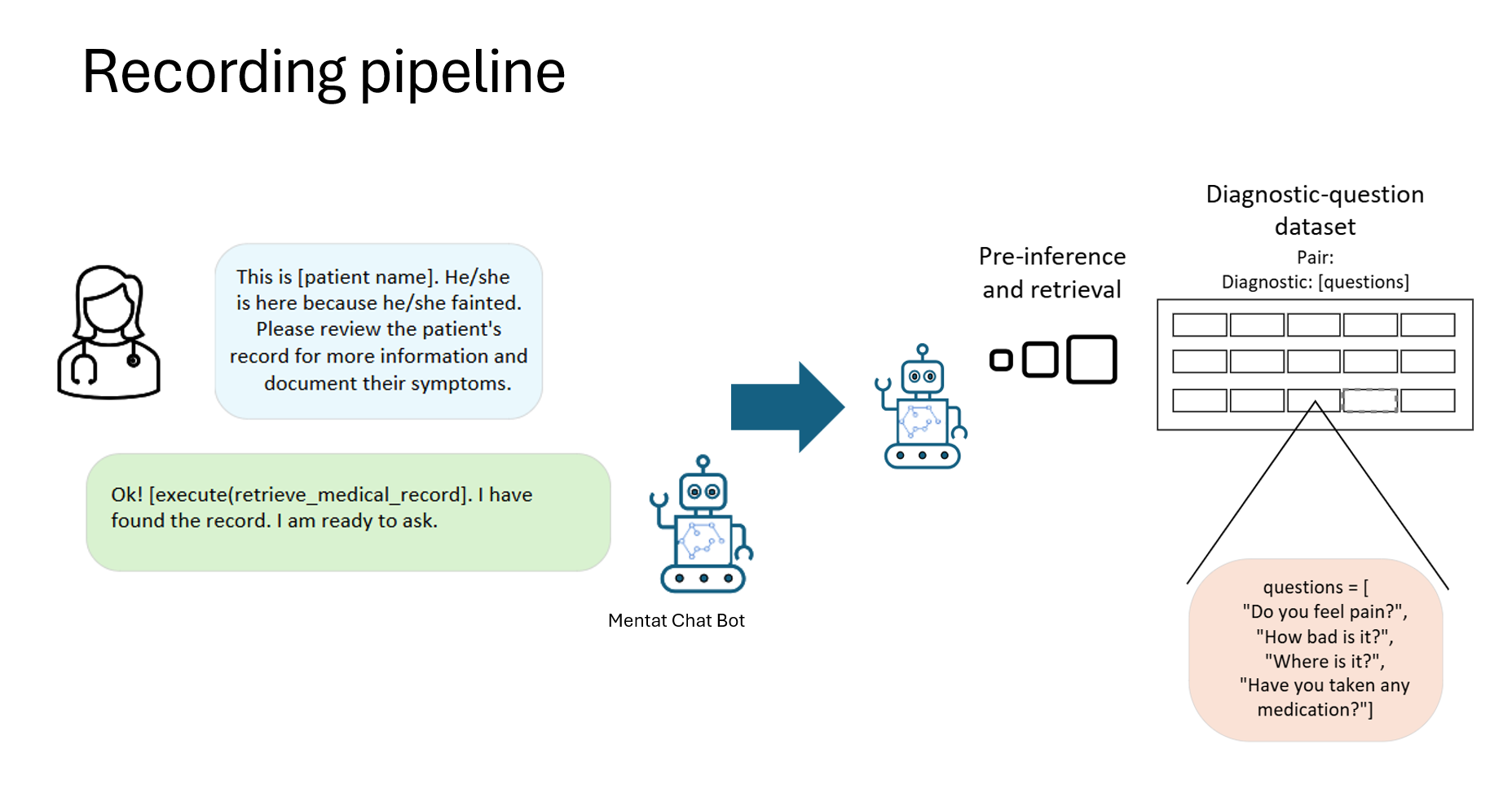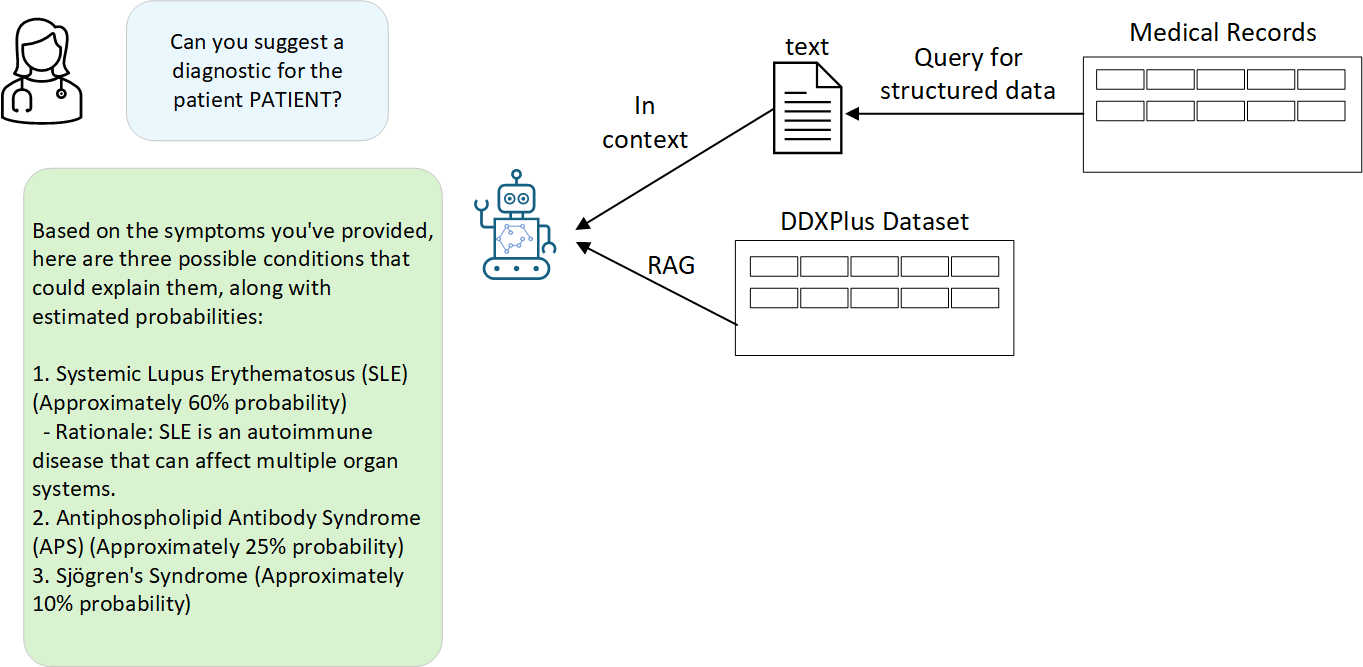Mentat Technology: An End-to-End System
Mentat combines natural language understanding with secure, locally hosted inference to streamline medical data collection and support clinical decision-making. The following sections illustrate how Mentat moves from conversation-based data gathering to inference and retrieval-augmented generation (RAG).
Recording Pipeline
Mentat begins by automating patient data collection through conversation prompts. A medical professional initiates the process, and Mentat’s language model guides the dialogue until all necessary information is gathered.
How It Works
-
Triggered Template
When a medical professional makes a request—e.g., “Please document the patient’s symptoms”—Mentat starts a conversation template in which the model prompts the patient (or the professional) with relevant questions. - Sequential Q&A
- The model uses regular expressions plus a function f(q) to rephrase or refine questions.
- Answers are parsed with syntactic decomposition to extract key logical values.
- These values dictate the next questions and build context for the eventual diagnostic step.
- Condition Check & Data Saving
- Once a stopping criterion is met—i.e., enough information is gathered—the conversation concludes.
- All captured text is organized into structured categories by internally prompting the language model.
- This information is stored in JSON format for easy retrieval and parsing later on.
Software & Language Model
Mentat uses Phi 3.5 mini, deployed via LlamaEdge, to handle natural language tasks efficiently:
- Context Window
We have set a context limit of 32,000 tokens to evaluate and manage memory usage. - No Fine-Tuning
During both implementation and testing, we used the base model without additional fine-tuning. - Proactive Prompts
Mentat maintains a continuous conversation by using a sequence of question templates that iteratively engage the model until it completes the data-collection task.
Inference, Databases, and RAG
After data collection, Mentat shifts into an inference mode to support clinicians:
- Structured Data Retrieval
- A medical specialist selects a patient.
- Mentat queries its local database for the structured information (in JSON) gathered during the recording phase.
- Pre-Diagnostic Generation
- The model uses the patient’s structured information as context.
- It produces a pre-diagnostic, which is essentially a textual summary of the potential issues or next steps.
- Retrieval-Augmented Generation (RAG)
- Mentat employs a retrieval pipeline to fetch additional medical references from a local corpus.
- RAG integrates database queries and the model’s knowledge to bolster the pre-diagnostic with relevant facts, common treatments, or cautionary notes.
Few-Shot Prompting
Mentat adapts to new clinical scenarios by incorporating few-shot prompting:
- Minimal Labeled Data
The model can handle specific tasks with limited examples. - In-Context Learning
We provide short demonstrations or instructions, and Mentat then refines its outputs accordingly. - Improved Adaptability
This approach enhances Mentat’s ability to handle diverse medical inquiries and maintain consistent answer formatting.
Putting It All Together
Below is a schematic illustrating how Mentat blends RAG and tokenization to move from a clinician’s question to a grounded diagnostic suggestion:

Figure 3. Schematic for retrieval-augmented generation with BioBERT embeddings.
- Diagnostic & Corpus: Mentat takes the preliminary diagnostic and queries local medical records.
- BioBERT Tokenization: Converts text into embeddings, capturing semantic context.
- Cosine Similarity: Ranks potential matches from the corpus.
- Grounded Diagnostic: Combines the matched information with the initial question and context to produce a final, structured suggestion.
Note: While Mentat aims to streamline patient data entry and provide supportive diagnostic insights, it is not a standalone diagnostic tool. Medical professionals remain the final authority on patient care and decisions.
Hardware
Our future design envisions a handheld tablet that remains offline and preserves data integrity:
- Nvidia Orin NX 16GB – Core GPU for local inference.
- ReComputer J4012 – Carrier board for Orin NX.
- ReSpeaker Lite – For natural language processing.
- Touch Screen & Speaker – For interactive and audio outputs.
- Custom 3D-Printed Case – Protects internal components.
Conclusion
By integrating proactive conversation templates, structured data storage, few-shot learning, and retrieval-augmented generation, Mentat provides a robust, human-in-the-loop system. This end-to-end approach helps medical teams collect patient data more reliably and generate targeted insights without compromising on security or data privacy.

